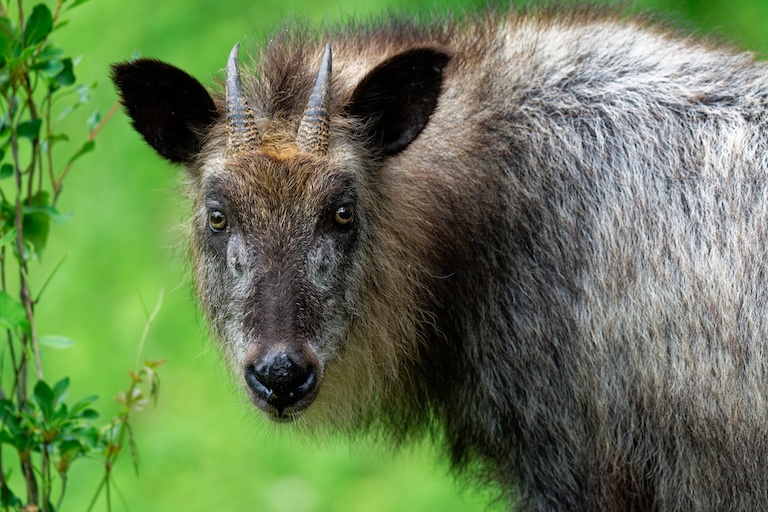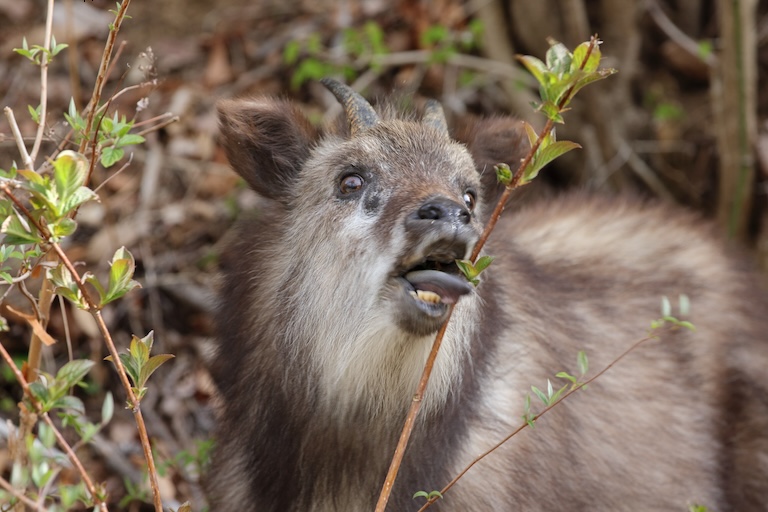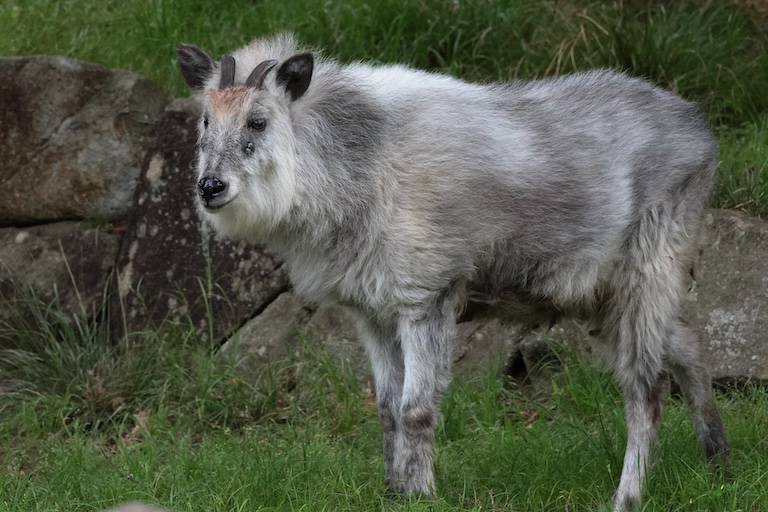Japanese Serow Profile
It would be more believable if astrologists listed negative traits assigned to the star signs: Geminis are morbidly obese; Leos are all addicted to porn; Scorpios are real jerks, etc. But even if that were the norm, it would still be hard to say a bad word against Capricornis.
Their Latin name sounds like a breakfast cereal but there’s nothing crunchy about this crispus. This shaggy goat-antelope is a Japanese national treasure named the Japanese serow.

Japanese Serow Facts Overview
| Habitat: | Dense mountain forests |
| Location: | Japan |
| Lifespan: | Up to 25 years |
| Size: | 80cm (32 inches) tall |
| Weight: | Up to 45kg (99lb) |
| Colour: | Dark to light grey, sometimes black with a white stripe |
| Diet: | Forest vegetation, leaves, plant shoots, and acorns |
| Predators: | Japanese wolf (now extinct), Japanese black bear |
| Top Speed: | Unknown |
| No. of Species: | 1 |
| Conservation Status: | Least Concern (IUCN) |
Serows are a small genus of animals that don’t really have a common descriptor.
They’re not quite goats and not quite antelopes, but rather a branch of bovids somewhere in between; agile, powerful and shaggy old things that mind their own business in Central and Eastern Asia.
The Japanese Serow is one of the four species confined entirely to four islands in Japan.
Interesting Japanese Serow Facts
1. They’re mostly goats
Serows are bovids, and more than this, they’re in the Caprinae subfamily, which puts them in cahoots with some of the coolest and most overlooked herbivores. Sheep and goats are in this club and they do a good job of representing the horny mountain specialists, but there are plenty of others to look out for, too.
The Serow’s closest relative is the Goral, which looks pretty similar, and they’re both a sort of half-goat, half-antelope kind of animal. Like so many in the subfamily, Serows live on the rocky mountain heights, feeding on plant matter and generally being awesome.

2. They’re very Asian
Japanese serows exist in three places: primarily, the islands of Honshu, Shikoku and Kyushu. They are the only ruminants in Japan and occupy wooded areas up to around 1km in altitude.
As if keeping with the local cuisine, Japanese Serows produce sweet-and-sour sauce from their faces. These preorbital secretions are used to define territories for what is essentially a solitary animal, and they rub it on branches and trees to make it clear to others that they live here. 1
3. They’re agile
In keeping with the Asian theme, these are relatively nimble animals when compared with their Western counterparts.
They aren’t as bulky as the Eurasian Ibex or the American mountain goats, and they handle craggy cliffs with ease. They can jump from cliff to cliff and sprint around on rocky faces without too much ankle twisting, and they do so when foraging or marking out their territories.
They have powerful yet dextrous hooves that are perfectly adapted to rocky terrain. 2
4. Could they be the 8th-century shishis?
The Japanese history with the Serow goes way back. An 8th-century poem refers to a group of shishi, which may or may not refer to this animal, but traditional medicine from around 800AD does refer to it, as well as mentions of serow horn used as a gift.
Whether the shishi was the Serow or not is debatable, though there aren’t all that many contenders. One piece of evidence that points against it is that serows don’t really form groups.
5. They’re mostly solitary
These goatly caprines are not the most social of animals, preferring to spend most of their lives alone. Males and females may have overlapping territories, but in general, they keep to themselves.
The largest group you’re likely to find include a mother and her single young or twins. Breeding pairs are very temporary, though the males might overlap with more than one female at the same time. They appear to stay in the same territories for a long time, perhaps a decade or more. 3
6. They were hunted almost to extinction
Being a national treasure in Japan has not saved this species from hunting pressure. Traditionally, the Matagi, the Winter hunters of the Northernmost parts of Honshu, would hunt both bears and serows with equal pride.
Even today, there is conflict among these traditional people and modern conservationists who are concerned about overhunting and unchecked deforestation, and while the serow was once a highly valued kill, it is no longer hunted, after being protected in 1925.
Until then, the outlook for the Japanese serow was bleak, and it was in steep decline across its range, bringing its population to as low as 2000 in the whole of Japan. 4

7. Anti-poaching campaigns have worked
Even after protections were put in place, illegal hunting continued to threaten the species until the ‘50s. A powerful anti-poaching campaign at the end of the decade saw the problem almost disappear, and populations began recovering again.
The Japanese serow is now listed as of least concern by the IUCN, and its only major issues are the new overlap with the Sika deer and the reduction of forest cover that continues to reduce habitat for the species. 5
8. Sikas might be taking over
There has been a marked increase in Sika deer in the range of the Japanese Serow. While the serow is strictly a browser of woody plants, the Sika has a much more flexible diet, so the concern is that the Sika can outcompete the serow.
While it’s true that the sika are increasing in population density, as of yet, it seems like the diet of the serow is still stable, and populations are so far unaffected. But whether the sikas and the serows figure out a handy system of spatial partitioning or serows push into less hospitable conditions in search of food as the Sika increases in density.
It remains to be seen what will happen to the little serow.

Japanese Serow Fact-File Summary
Scientific Classification
| Kingdom: | Animalia |
| Phylum: | Chordata |
| Class: | Mammalia |
| Order: | Artiodactyla |
| Family: | Bovidae |
| Genus: | Capricornis |
| Species: | Crispus |
Fact Sources & References
- Agungpriyono S (2006), “Histomorphology of preorbital gland in territorial and non-territorial male blackbuck Antelope cervicapra, a critically endangered species”, Springer Link.
- sigma1920HD (2024), “A Simple Way to Make a Curious Japanese Serow Come Closer to You”, YouTube.
- Kensuke Mori, “Capricornis crispus Japanese serow”, Animal Diversity Web.
- “It’s Not a Goat, It’s a Japanese Serow!”, iNaturalist.
- “Japanese Serow”, IUCN Red List.
